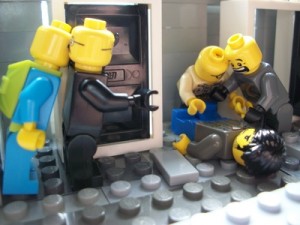INFINITE JEST Readalong Week 1

Welcome to the Infinite Summer, and Infinite Jest readalong, Twin Cities 2015 version. Anyone can read along. We can discuss the book’s sections (no spoilers) in the comments, and on Twitter with the hashtag #InfiniTC. This week we read to page 63. I posted a summary and list of characters for week 1 here.
Infinite Jest pages 1-63.
The first time I read Infinite Jest, I approached it like a diligent student. I took notes, wrote each character and when they appeared, and approached it like a puzzle to be solved.
I wish I’d just read the damn thing. Having gotten to the end, I know that what seems overwhelming at first makes more and more sense as you go along. The internet can be used to remind you of character lists and what happened in which section if you want to go back.
This time, because I’m blogging and tweeting the book, I have to nerd out, at least a little. I’m reading a guide, Elegant Complexity by Greg Carlisle. I will share bits of it each week, trying not to overwhelm with minutiae.
For first-time readers, I think the main thing to know is Infinite Jest jumps around in time and point of view and plot. It starts off as many little bits, and will coalesce into a greater whole. If you’re confused, that’s not only normal, it’s probably what the author intended.
In a 1995 radio interview, Wallace said that the structure of the unedited first draft of Infinite Jest was based on a fractal object called a Sierpinski Gasket, generated geometrically by an iterative process of cutting smaller triangle-sized holes out of larger triangles…readers of IJ construct narrative interpretations “as much out of what’s missing as what’s there” (IJ p681) (Carlisle, p20)

Here are some things I noticed on this read, many of which are questions:
DFW’s terrific and funny sentences, like “My chest bumps like a dryer with shoes in it. (5) and “I do things like get in a taxi and say, ‘The library, and step on it.’ (12) Or “a fit of febrile thrushive pique”that the attache is told to pay no mind, “because it’s just the yeast talking” (35). Or “promoted” as a euphemism for stolen. I keep finding more: “The rhinovirally afflicted man, gagged with skill and quality materials (59)
I think Pemulis is pronounced “PEEM you liss”
Why does DFW use single quotes for dialogue? Is it merely the convention he chose, or is it mean to imply that all of the book is in full quotes, so all dialogue is embedded?
The first line of Hamlet is “Who’s there?” The first line of Infinite Jest (a phrase from Hamlet) is “I am.”
This seemingly throwaway sentence haunts me with its questions:
I think of John N.R Wayne, who would have won this year’s WhataBurger, standing watch in a mask as Donald Gately and I dig up my father’s head. (16-17)
Wayne would have won, if not for what? Why are they digging up the father’s head?
Masking is a theme that will repeat through the novel. Another theme is defecation, as it was in Ulysses. Carlisle notes that several scenes take place “in men’s rooms, locker rooms, and toilet stalls–places in which waste is produced.” (Carlisle, 29) On page 9, Hal is in a “defecatory posture.” Later, Tavis is “a truly unparalleled slinger of shit.”
I urge you to visit Brickjest.com, which features scenes from the book re-created with Legos.

I am rolled supine on the geometric floor. (13)
In Erdedy’s section we read about a drug dealer:
“he lived in a trailer and had a harelip and kept snakes” (18)
who shows up again in Bruce Green’s section:
“he and Mildred Bonk and tiny incontinent Harriet Bonk-Green lived just off he Allston Spur in a shiny housetrailer with another frightening couple and with Tommy Doocey, who kept several large snake in unclear uncovered aquaria, which smelled, which Tommy Doocey didn’t notice because his upper lip completely covered his nostrils and all he could smell was lip.” (39)
I’m not sure what makes me laugh more, the realization that tiny, incontinent refers to a baby, or “all he could smell was lip.”
Less amusing, though, is pondering how vivid the detail of Erdedy’s pot obsession was, which I surmise DFW knew from personal experience, just as the drug dealer was based on one in real life. This is a description from Mary Karr’s The Liar’s Club(p76):
I knew a drug dealer once who collected them [snakes] in glass tanks all over his trailer. He had a harelip that somehow protected him from the stink, but the rest of us became, when dickering over pharmaceuticals with him, the noisiest and most adenoidal mouth breathers.
Karr and DFW were together for a time, which she writes about in her memoir Lit and talked about at Salon here:
He was in rehab and we’d met through friends; he was in rehab down the street and I lived in Belmont, Mass…. I was about a month clean; his sobriety date was about a month after mine. So we ran into each other a lot. He was in a halfway house where I did volunteer work.
Another question: Hal tries to communicate to the college people, then says ‘Call it something I ate’ before he relates a flashback to a scene of him eating mold as a child. Is there a connection between the mold and Hal’s inability to make himself understood?
EDITED TO ADD: DFW was a fanatic about usage, and one example is his repeated, correct but often misunderstood use of the word nauseous, which means causing nausea, not feeling it.
Also of delight, the term ‘howling fantods’ for extremes of creeped-out-ed-ness. Apparently the real DFW’s mom added “howling” to fantods (a real word) to coin the term, HT Brain Pickings.
Also, the site Howling Fantods is a wealth of DFW information.
I think that’s more than enough from me. What did everyone else think?
For next week Tuesday 6/30, read in books to page 127’s chapter break, marked with a shaded circle. E-readers, see text quotes on the schedule below.
The rest of the schedule:
 Infinite Summer 2015
Infinite Summer 2015
Tu 6-30 discuss and tweet to 127. Start at “AS OF Y.D.A.U. “The Enfield Tennis Academy has been in accredited…” Stop at: “An oiled guru sits in yogic full lotus”
Tu 7-7 discuss and tweet to 181. Stop at: LATE OCTOBER Y.D.A.U. “Open me anothowone”
Tu 7-14 discuss and tweet to 258. Stop at: 6 NOVEMBER Y.D.A.U. “White halogen off the green”
Tu 7-21 discuss and tweet to 321. Stop at: 8 NOVEMBER Y.D.A.U. INTERDEPENDENCE DAY GAUDEAMUS IGITUR
Tu 7-28 discuss and tweet to 398. Stop at: “FREAK STATUE OF LIBERTY ACCIDENT”
Tu 8-04 discuss and tweet to 489. Stop at: PRE-DAWN. 1 MAY Y.D.A.U. OUTCROPPING
Tu 8-11 discuss and tweet to 538. Stop at: “It is starting to get quietly around Ennet”
Tu 8-18 discuss and tweet to 619. Stop at: “Year of the Depend Adult Undergarment: Interlace TelEntertainment, 932/1864”
Tu 8-25 discuss and tweet to 686. Stop at: 11 NOVEMBER Y.D.A.U. “First thing after supper”
Tu 9-1 discuss and tweet to 755. Stop at: 11 NOVEMBER Y.D.A.U. “Part of Mario’s footage”
Tu 9-8 discuss and tweet to 808. Stop at: “The ceiling was breathing”
Tu 9-15 discuss and tweet to 896. Stop at: “I was going to go back up”
Tu 9-22 discuss and tweet to 981. THE END!
June 23rd, 2015 at 11:15 pm
Some of us still keep those usage points. For a living. Here’s how I remember it: Nauseous is to nauseated as poisonous is to poisoned.
June 27th, 2015 at 2:46 pm
Thanks for this very informative post and the post outlining character descriptions for each chapter!
DFW is definitely another author with a commanding handle on language, and that’s all I could focus on in this chapter. Still not a fan of endnotes, though (make them footnotes in the next edition, please, publishers)!
Here are some of my favorites:
A summary of an everyday act: “I compose what I project will be seen as a smile.” (5)
A case of repetition and rhyme: “I presume it’s probably facilitate that the tennis coach mistook for account, though accelerate, while clunkier than facilitate, is from a phonetic perspective more sensible, as a mistake.” (6)
An astute observation: “Money created a sense of obligation.” (18)
Another astute observation: “the deprived panic over missing something made no sense.” (26)
An intriguing thought: “people are virtually unlimited in their need to give themselves away.” (53)
This “gentle fiction.” (endnote #10)
And of course, a comedic winner: “He took zero in the way of shit.” (55)
June 28th, 2015 at 5:50 pm
Re-reading this book for (I believe) the sixth time now, I’m struck all over again by how easy I find Wallace’s language, in spite of how difficult many people find reading this book. I say this not to brag, but just to observe that for whatever reason I just line up with the way he uses language. I think, as some people have opined with other large, dense works like Ulysses, that the best way to read it (especially the first time through) is to dissect it carefully. In many ways, I think it’s best if you just let yourself be carried along by it.
After all — and this is something that’s striking me newly — this is essentially science fiction in many ways, which is kind of cool to realize. A lot of the involuted history and techspeak is more window-dressing and world-building than anything else. This observation, though, did make me wonder: WHY is it science fiction? I guess the most obvious answer is that Wallace is primarily interested in entertainment and addiction here, and wanted to push the narrative out far enough that those two things became more and more tightly linked.
FWIW, the endnotes are a lot easier in the iBooks version, where you can just bop back and forth with a click. This now means I own three different editions of this book. I have a Wallace problem.
June 28th, 2015 at 6:13 pm
Oh and one other thing: It’s much clearer to me now that for all its sprawl, this is a book that has most definitely been edited. I can’t remember exact numbers but I feel like the manuscript he initially submitted was maybe twice this long? A lot of that ended up in endnotes, but I know a lot got cut and it’s very clear when it’s placed next to books like The Instructions by Adam Levin, which starts with a ton of energy and then flags hugely. Apparently, Levin sent it in expecting the chopping block but then they mostly left it. Kind of a comment on modern editing, too, I think.
But like in IJ there is a pull that carries you through it, beginning with the mystery of Hal in the waiting room and then leading into the mystery of what is happening with the medical attaché. For all its digressions into stasis and inaction and stuff in characters’ heads — I’m thinking of the chapter that ends with Erdedy frozen deciding between door buzzer and phone — the book does actually have a plot. Without that, I think it would fall on its face.
June 28th, 2015 at 7:12 pm
I’m not sure I can agree with Dave Eggers’ assertion in the intro that there’s not one word that could be cut, but I agree and can see on this, my second read, that it is focused, though it seems to sprawl. I love the multitude of mysteries–why is Hal mute and weird? Why was he digging up his head? What’s the deal with the years? And why on earth that Wardine section that is so different from all the rest?
I too love his language. It’s poetic, it’s fun, it’s funny. I also think, as with most other writers like shakespeare, Austen, Dickens, (and perhaps Joyce’s Ulysses) that I develop a facility with practice.
June 28th, 2015 at 10:32 pm
I mean, it’s not like Eggers is an exemplar of knowing what needs to be cut, but I get what he’s saying from the perspective that it needs a certain sprawl to be IJ. Is a 750-page IJ necessarily a better one? From the perspective of someone who likes to get immersed in it, not necessarily.
Although there is one exception to this that I can bring up next week.